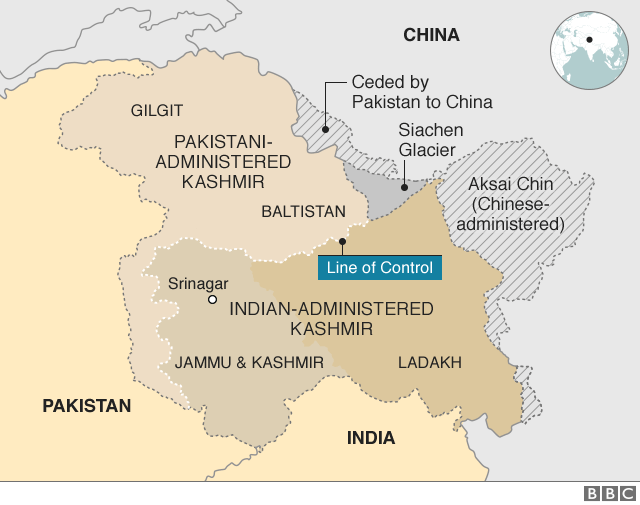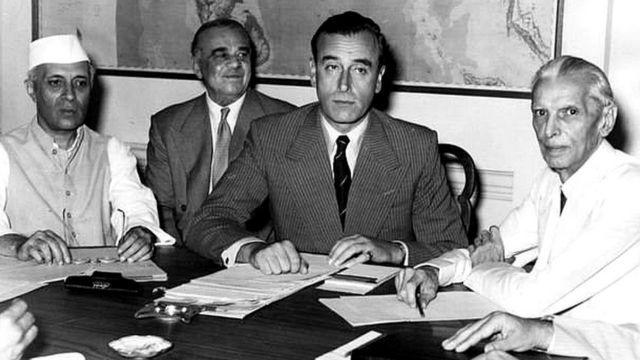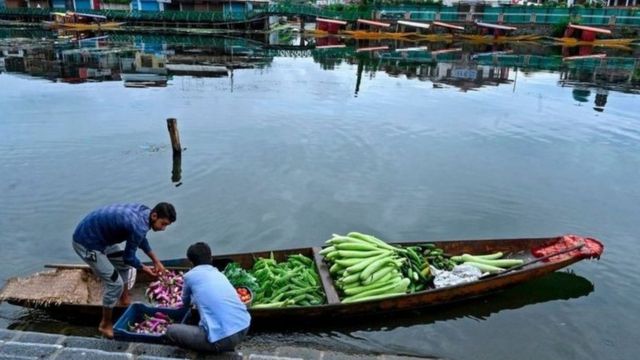Source: Indian/Pakistani Government Censuses | Scenario one: The status quo Kashmir has been a flashpoint between India and Pakistan for more than 50 years. Currently a boundary - the Line of Control - divides the region in two, with one part administered by India and one by Pakistan. India would like to formalise this status quo and make it the accepted international boundary. But Pakistan and Kashmiri activists reject this plan because they both want greater control over the region. In 1947-8 India and Pakistan fought their first war over Jammu and Kashmir. Under United Nations' supervision, they agreed to a ceasefire along a line which left one-third of the state - comprising what Pakistan calls Azad Jammu and Kashmir, and the Northern Areas administered by Pakistan and two-thirds, Jammu, Ladakh and the Kashmir Valley, administered by India. In 1972, under the terms of the Simla agreement, the ceasefire line was renamed the Line of Control. Although India claims that the entire state is part of India, it has been prepared to accept the Line of Control as the international border, with some possible modifications. Both the US and the UK have also favoured turning the Line of Control into an internationally-recognised frontier. But Pakistan has consistently refused to accept the Line of Control as the border since the predominantly Muslim Kashmir Valley would remain as part of India. Formalising the status quo also does not take account of the aspirations of those Kashmiris who have been fighting since 1989 for independence for the whole or part of the state. |
Source: Indian/Pakistani Government Censuses | Scenario two: Kashmir joins Pakistan Pakistan has consistently favoured this as the best solution to the dispute. In view of the state's majority Muslim population, it believes that it would vote to become part of Pakistan. However a single plebiscite held in a region which comprises peoples that are culturally, religiously and ethnically diverse, would create disaffected minorities. The Hindus of Jammu, and the Buddhists of Ladakh have never shown any desire to join Pakistan and would protest at the outcome. In 1947 India and Pakistan agreed that the allegiance of the state of Jammu and Kashmir would be decided by a plebiscite. Had the majority voted in favour of Pakistan, the whole state would have become part of Pakistan. This no longer seems to be an option. A plebiscite offering the choice of union with Pakistan or India also does not take into account the movement for independence which has been supported by political and militant activists since 1989. India has long since rejected the idea of a plebiscite as a means of settling the Kashmir issue. Instead the government argues that the people have exercised their right of self-determination by participating in elections within the state. However the demand for a plebiscite to be held, as recommended by the Governor-General of India, Lord Mountbatten in 1947, and endorsed by the United Nations Security Council, is still considered by some as a way of letting Kashmiris exercise their right of self-determination. |
Source: Indian/Pakistani Government Censuses | Scenario three: Kashmir joins India Such a solution would be unlikely to bring stability to the region as the Muslim inhabitants of Pakistani-administered Jammu and Kashmir, including the Northern Areas, have never shown any desire to become part of India. In 1947, the Maharajah of Jammu and Kashmir agreed to the state becoming part of India. India and Pakistan then agreed to hold a plebiscite to confirm which country Kashmir's citizens wanted to join. The Indian Government believed that the majority population, under the charismatic leadership of Sheikh Abdullah, would vote to join India, with its secular constitution, rather than Muslim Pakistan. If the plebiscite had been held and the majority had voted in favour of India, Pakistan would have had to relinquish control of the Northern Areas and the narrow strip of Jammu and Kashmir which it occupied militarily in 1947-8. India has long since rejected the idea of holding a single plebiscite as a means of determining the fate of the state of Jammu and Kashmir. It believes that the people made their choice by participating in elections within the state. Without including a third option of independence from both India and Pakistan, the plebiscite also fails to satisfy the demands of those Kashmiris wanting full independence. |
Source: Indian/Pakistani Government Censuses | Scenario four: Independent Kashmir The difficulty of adopting this as a potential solution is that it requires India and Pakistan to give up territory, which they are not willing to do. Any plebiscite or referendum likely to result in a majority vote for independence would therefore probably be opposed by both India and Pakistan. It would also be rejected by the inhabitants of the state who are content with their status as part of the countries to which they already owe allegiance. An independent Jammu and Kashmir might also set in motion the demand for independence by other states in both India and Pakistan and lead to a "Balkanisation" of the region. In the 1960s, following discussions between India and Pakistan over Jammu and Kashmir, a group of Kashmiris demanded that the entire state should become independent as it was prior to the Maharajah's accession to India in 1947. The movement for independence of the entire state is mainly supported by Kashmiris who inhabit the more populous Kashmir Valley and who would like both India and Pakistan to vacate the areas they are occupying. They base their claim on the fact that the state was formerly an independent princely state, is geographically larger than at least 68 countries of the United Nations, and more populous than 90. This movement is not supported by India or Pakistan, both of which would lose territory. And in view of the likely regional instability, an independent Kashmir is not supported by the international community either. |
Source: Indian/Pakistani Government Censuses | Scenario five: A smaller independent Kashmir An independent Kashmir could be created from the Kashmir Valley - currently under Indian administration - and the narrow strip of land which Pakistan calls Azad Jammu and Kashmir. This would leave the strategically important regions of the Northern Areas and Ladakh, bordering China, under the control of Pakistan and India respectively. However both India and Pakistan would be unlikely to enter into discussions which would have this scenario as a possible outcome. If, as the result of a regional plebiscite, which offered the option of independence, the majority of the inhabitants of the Kashmir Valley chose independence and the majority of the inhabitants of Pakistani-administered Jammu and Kashmir, (excluding the Northern Areas) also chose independence, a smaller, independent Kashmir could be created by administratively joining these two areas together. This would leave the predominantly Muslim Northern Areas as part of Pakistan and Buddhist Ladakh and majority Hindu Jammu as part of India, with the possibility that some Muslim districts of Jammu might also opt to join the independent state. Although Pakistan has demanded a change in the status of the Kashmir Valley, it depends on water from the Mangla Reservoir in Pakistani-administered Jammu and Kashmir and would be unlikely to permit loss of control of the region. India is still committed to retaining the Kashmir Valley as part of the Indian Union and has refused to consider holding a plebiscite in any part of the state. Regardless of the aspirations of the inhabitants, to date neither country has contemplated a situation where the end result would adversely affect their own interests. |
Source: Indian/Pakistani Government Censuses | Scenario six: Independent Kashmir Valley An independent Kashmir Valley has been considered by some as the best solution because it would address the grievances of those who have been fighting against the Indian Government since the insurgency began in 1989. But critics say that, without external assistance, the region would not be economically viable. The movement for independence in the Kashmir Valley gained momentum in the late 1980s when Kashmiris protested against their continuing allegiance to the Indian Union. In the present day, if a regional plebiscite offered independence as an option, it is possible that the majority of Kashmiris would vote in favour of independence. With an approximate land mass of 1,800 square miles (80 miles long, 20 to 25 miles wide) it is much larger than Monaco and Liechtenstein – but only one-tenth of the size of Bhutan. Whether or not the rest of the state retained its current political affiliations, many Kashmiris therefore believe that the valley could be viable in its own right. In terms of livelihood, the valley could sustain itself through tourism, handicrafts and agriculture. But an independent Kashmir Valley would also need to retain good relations with its neighbours in order to survive economically. Not only is the region landlocked, but it is snowbound during winter. An independent Kashmir Valley would have the advantage of giving neither Pakistan nor India a victory out of their longstanding dispute. But although Pakistan might favour the creation of an independent Kashmir Valley, India would be unlikely to agree to the loss of territory involved. Autonomy of the same region under the Indian Union is also an option; Pakistan is more likely to request a 'joint protectorate' in order to share in safeguarding the Kashmir valley's political integrity and economic development. |
Source: Indian/Pakistani Government Censuses | Scenario seven: The Chenab formula This plan, first suggested in the 1960s, would see Kashmir divided along the line of the River Chenab. This would give the vast majority of land to Pakistan and, as such, a clear victory in its longstanding dispute with India. The entire valley with its Muslim majority population would be brought within Pakistan's borders, as well as the majority Muslim areas of Jammu. With the inclusion of Ladakh, which also lies north of the Chenab river, India would be left with approximately 3,000 square miles of territory out of 84,000 square miles. This solution would require the voluntary agreement of India to give up territory which it wants to retain. It is impossible to see what benefit India could derive from the transfer of so much land, and why the government - or the inhabitants of the region who are not contesting their status - would ever agree to such a solution. It also does not take into account the movement for independence which has been extremely vocal ever since the insurgency began in the 1980s, and whose supporters have been demanding independence of all or part of the state. |























No comments
Post a Comment